Gujarat Board GSEB Textbook Solutions Class 7 Maths Chapter 11 Perimeter and Area Ex 11.3 Textbook Questions and Answers.
Gujarat Board Textbook Solutions Class 7 Maths Chapter 11 Perimeter and Area Ex 11.3
![]()
Question 1.
Find the circumference of the circles with the following radius: ( Taken π = \(\frac { 22 }{ 7 }\) )
(a) 14 cm
(b) 28 mm
(c) 21 cm
Solution:
(a) Here, radius (r) = 14 cm
∴ Circumference (C) = 2πr
= 2 x \(\frac { 22 }{ 7 }\) x 14 cm = 2 x 22 x 2 cm
= 88 cm
(b) Here, radius (r) = 28 mm
∴ Circumference (C) = 2πr
= 2 x \(\frac { 22 }{ 7 }\) x 28 mm
= 2 x 22 x 4 mm = 176 mm
(c) Here, radius (r) = 21 cm
∴ Circumference (C) = 2πr
= 2 x \(\frac { 22 }{ 7 }\) x 21 cm
= 2 x 22 x 3 cm = 132 cm
![]()
Question 2.
Find the area of the following circles, given that: ( Taken π = \(\frac { 22 }{ 7 }\) )
(a) radius = 14 mm
(b) diameter = 49 m
(c) radius = 5 cm
Solution:
(a) Here, radius (r) = 14 mm
∴ Area of the circle = π²
= \(\frac { 22 }{ 7 }\) x (14)² mm²
= \(\frac { 22 }{ 7 }\) x 14 x 14 mm²
= 22 x 2 x 14 mm² = 616 mm²
(b) Here, diameter = 49 m
∴ Radius (r) = \(\frac { 49 }{ 2 }\)m
Now, area of the circle = πr²
= \(\frac { 22 }{ 7 }\) x \(\frac { 49 }{ 2 }\)² m²
= \(\frac { 22 }{ 7 }\) x \(\frac { 49 }{ 2 }\) x \(\frac { 49 }{ 2 }\)m²
= 22 x \(\frac { 7 }{ 2 }\) x \(\frac { 49 }{ 2 }\) m²
= \(\frac { 11 ×7×49 }{ 2 }\)m²
= \(\frac { 3773 }{ 2 }\)m²
= 1886.5 m²
(c) Here, radius (r) = 5 cm
Area of the circle = πr²
= \(\frac { 22 }{ 7 }\) x (5 cm)²
= \(\frac { 22 }{ 7 }\) x 5 x 5 cm²
= \(\frac { 550 }{ 7 }\)cm²
![]()
Question 3.
If the circumference of a circular sheet is 154 m, find its radius. Also find the area of the sheet. ( Taken π = \(\frac { 22 }{ 7 }\) )
Solution:
Here, the circumference of the circle = 154 m.
Consider radius = r m

Question 4.
A gardener wants to fence a circular garden of diameter 21 m. Find the length of the rope he needs to purchase, if he makes 2 rounds of fence. Also find the cost of the rope, if it costs ₹ 4 per metre. ( Taken π = \(\frac { 22 }{ 7 }\) )
Solution:
Diameter of the circular garden = 21 m
∴ Radius (r) = \(\frac { 21 }{ 2 }\)
∵ Circumference (C) = 2πr
∴ Circumference of the circular garden
= 2 x \(\frac { 22 }{ 7 }\) x \(\frac { 21 }{ 2 }\) m
= 22 x 3 m
= 66 m
Since, the rope makes 2 rounds of fence.
∴ Length of the rope = 2 x [Circumference of the garden]
= 2 x 66 m = 132 m
Thus, the length of the required rope = 132 m Now,cost of the rope = ₹ 4 x 132 = ₹ 528.
Question 5.
From a circular sheet of radius 4 cm, a circle of radius 3 cm is removed. Find the area of the remaining sheet. (Take π = 3.14)
Solution:
Radius of the circular sheet (R) = 4 cm.
Radius of the removed circular sheet (i.e. inner circle) (r)= 3 cm
Since, Area of a circle = π x (Radius)²

∴ Area of the remaining sheet = [Area of outer circle] – [Area of inner circle]
= πR² – πr² = π[R² – r²]
= π(R – r)(R + r)
= 3.14(4 – 3)(4 + 3) cm²
= 3.14(1)(7) cm² = 21.98 cm²
Question 6.
Saima wants to put a lace on the edge of a circular table cover of diameter 1.5 m. Find the length of the lace required and also find its cost if one metre of the lace costs ₹ 15. (Take π = 3.14)
Solution:
Diameter of the circular table cover = 1.5 m.
∴ Radius (r) = \(\frac { 1.5 }{ 2 }\)m
∴ Circumference (C) = 2πr
= 2 x \(\frac { 22 }{ 7 }\) x \(\frac { 1.5 }{ 2 }\)m
= \(\frac { 22×1.5 }{ 7 }\)m = 4.71m
Thus, the length of the lace required = 4.71 m.
Now, cost of lace = ₹ 15 x 4.71 = ₹ 70.71
Question 7.
Find the perimeter of the figure, which is a semicircle including its diameter.
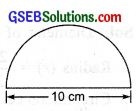
Solution:
Diameter of the semicircle = 10 cm
∴ Radius (r) = \(\frac { 10 }{ 2 }\) = 5 cm
Now, circumference of the semicircle = \(\frac { 2πr }{ 2 }\) = πr
= \(\frac { 22 }{ 7 }\) x 5 cm
= \(\frac { 110 }{ 7 }\) cm = 15.71 cm
∴ Perimeter of the semicircle = Circumference + Diameter
= 15.71 cm + 10 cm = 25.71 cm
![]()
Question 8.
Find the cost of polishing a circular tabletop of diameter 1.6 m, if the rate of polishing is ₹ 15/m². (Take π = 3.14)
Solution:
Diameter of the circular table-top = 1.6 m
∴ Radius (r) = \(\frac { 1.6 }{ 2 }\)m
Now, area of the circular table-top = πr²
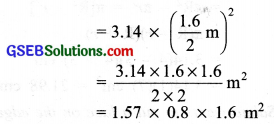
Since rate of polishing = ₹ 15/m²
∴ Total cost of polishing the circular table-top = ₹ 15 x [1.57 x 0.8 x 1.6] = ₹ 30.144.
Thus, the required cost of polishing the circular table-top = ₹ 30.144.
Question 9.
Shazli took a wire of length 44 cm and bent it into the shape of a circle. Find the radius of that circle. Also find its area. If the same wire is bent into the shape of a square, what will be the length of each of its sides? Which figure enclose more area, the circle or the square? ( Taken π = \(\frac { 22 }{ 7 }\) )
Solution:
Here, length of the wire = 44 cm
∵ The wire is bent in the form of a circle.
∴ Circumference of the circle so formed = 44 cm
Let the radius of the circle be r
∴ 2πr = 44
or 2 x \(\frac { 22 }{ 7 }\) x r = 44
or r = \(\frac { 44×7 }{ 2×22 }\) cm = 7 cm.
Thus, the required radius of the circle is 7 cm.
Now, area of the circle so formed = πr²
= \(\frac { 22 }{ 7 }\) x (7 cm)²
= \(\frac { 22 }{ 7 }\) x 7 x 7 cm² = 154 cm²
Since, the wire is rebent to form a square.
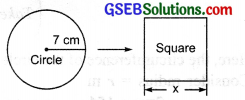
∴ [Perimeter of the square so formed] = [Circumference of the circle]
or
Perimeter of the square = 44 cm
Let the side of the square be x cm.
∴ 4 x x = 44 cm
(∵ Perimeter of a square = 4 x Side)
or x = \(\frac { 44 }{ 4 }\) cm = 11 cm
Now, area of the square = Side x Side
= 11 cm x 11 cm = 121 cm²
Since 154 cm² >121 cm²
∴ The circle encloses greater area.
![]()
Question 10.
From a circular card sheet of radius 14 cm, two circles of radius 3.5 cm and a rectangle of length 3 cm and breadth 1 cm are removed {as shown in the adjoining figure). Find the area of the remaining sheet. ( Taken π = \(\frac { 22 }{ 7 }\) )

Solution:
Radius of the circular sheet = 14 cm
∴ Area of the sheet = πr²
= \(\frac { 22 }{ 7 }\) x (14 cm)²
= \(\frac { 22 }{ 7 }\) x 14 x 14 cm²
= 22 x 2 x 14 cm² = 616 cm²
Now, radius of a small circle = 3.5 cm
∴ Area of a small circle = \(\frac { 22 }{ 7 }\) x 3.5 x 3.5 cm²
= 22 x 0.5 x 3.5 cm²
So, area of two small circles
= 2 x 22 x 0.5 x 3.5 cm²
= 22 x 1 x 3.5 cm² = 77 cm²
Again, length of small rectangle = 3 cm. and
breadth of the small rectangle = 1 cm
Area of the small rectangle = 3 x 1 cm² = 3 cm²
∴ Total area removed from the sheet = 77 cm² + 3 cm² = 80 cm²
Area of the remaining sheet
= 616 cm² – 80 cm² = 536 cm²
Thus, the required area of the remaining sheet = 536 cm².
Question 11.
A circle of radius 2 cm is cut out from a square piece of an aluminium sheet of side 6 cm. What is the area of the left over aluminium sheet?
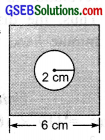
(Take π = 3.14)
Solution:
Side of the square = 6 cm
Area of the square = Side x Side = 6 cm x 6 cm = 36 cm²
Radius of the circle cut out from the sheet, r = 2 cm
∴ Area of the circle = πr² = 3.14 x (2 cm)²
= 3.14 x 2 x 2 cm² = 12.56 cm²
Now, area of the remaining sheet = 36 cm² – 12.56 cm² = 23.44 cm²
Question 12.
The circumference of a circle is 31.4 cm. Find the radius and the area of the circle.
(Take π = 3.14)
Solution:
Here, circumference of the circle = 31.4 cm
Let radius of the circle be r
∴ 2πr =31.4
or 2 x 3.14 x r = 31.4
or r = \(\frac { 31.4 }{ 2×3.14 }\) cm = 5 cm
Thus, radius of the circle (r)= 5 cm
Now, area of the circle = πr²
= 3.14 x (5 cm)²
= 3.14 x 5 x 5 cm²
= 78.5 cm²
![]()
Question 13.
A circular flower bed is surrounded by a path 4 m wide. The diameter of the flower bed is 66 m. What is the area of this path?
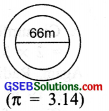
Solution:
∵ Diameter of the flower bed = 66 m
∴ Radius (r) = \(\frac { 66 }{ 2 }\) m = 33 m
Since width of the surrounding path = 4 m
∴ Radius of the outer circle (R)
= 33 m + 4 m = 37 m
Now, area of the outer circle = πR²
and area of the inner circle = πr²
∴ Area of the path = πR² – πr²
= π[R² – r²]
= π[(R + r)(R – r)]
= 3.14[(37 + 33)(37 – 33)] m²
= 3.14[70 x 4] m²
= 3.14 x 280 m²
= 879.2 m²
Thus, the area of the path = 879.2 m²
Question 14.
A circular flower garden has an area of 314 m². A sprinkler at the centre of the garden can cover an area that has a radius of 12 m. Will the sprinkler water the entire garden? (Take π = 3.14)
Solution:
Area of the circular garden = 314 m²
Let the radius of the garden be r m
∴ πr² = 314
or 314 x r² = 314
or \(\frac { 314 }{ 100 }\) x r² = 314
or r² = 314 x \(\frac { 100 }{ 314 }\) = 100
r² = 10² ⇒ r = 10 m
Now, radius of the area covered by the sprinkler = 12 m
Since 12 m > 10 m
∴ The sprinkler covers an area beyond the garden or we can say, yes, the entire garden is covered by the sprinkler.
![]()
Question 15.
Find the circumference of the inner and the outer circles, shown in the figure? (Take π = 3.14)
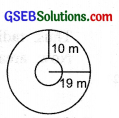
Solution:
Radius of the outer circle (R) = 19 m
∴ Circumference of the outer circle = 2πR
= 2 x 3.14 x 19 m = 119.32 m
Again, Radius of the inner circle (r)
= 19 m – 10 m = 9 m
∴ Circumference of the inner circle = 2πr
= 2 x 3.14 x 9 m = 56.52 m
Question 16.
How many times a wheel of radius 28 cm must rotate to go 352 m? ( Taken π = \(\frac { 22 }{ 7 }\) )
Solution:
Radius of the wheel (r) = 28 cm
∴ Circumference of the wheel = 2πr
= 2 x \(\frac { 22 }{ 7 }\) x 28 cm
= 2 x 22 x 4 cm = 176 cm
So, the wheel can cover 176 cm of distance in a rotation.
Total distance to be covered = 352 m
= 352 x 100 cm
∴ Number of rotations = \(\frac { 352×100 }{ 176 }\)
= 2 x 100 = 200
Thus, the distance of 352 m will be covered in 200 turns.
![]()
Question 17.
The minute hand of a circular clock is 15 cm long. How far does the tip of the minute hand move in 1 hour. (Take π = 3.14)
Solution:
∵ Length of the minute hand = 15 cm
∴ Radius of the circle made by the tip of the minute hand (r) = 15 cm.
Perimeter of the circle so formed = 2πr
= 2 x (3.14) x (15 cm) = 94.2 cm
Since, the minute hand describes one complete revolution in one hour.
Thus, the distance covered by the tip of the minute hand = 94.2 cm.